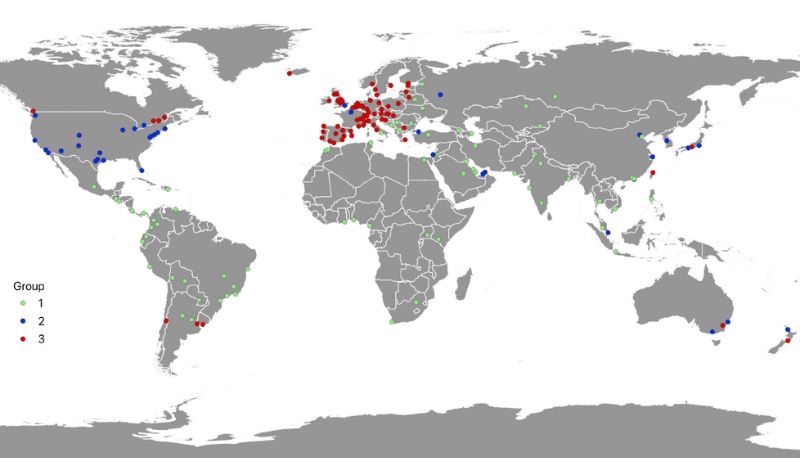
IESE Insight
Common challenges, similar responses: the world’s leading cities converge on strategy
Geopolitical tensions, energy crises and the effects of climate change push cities toward connected and sustainable urban models.
- London, New York and Paris lead the ranking for the third consecutive year, according to the IESE Cities in Motion 2025 Index.
- The 10th edition of this global ranking shows cities favoring similar responses to social, economic and geopolitical challenges.
- The study has added new metrics on women in leadership roles, female safety in urban environments, renewable energy use and urban green spaces.
For the third year in a row, London, New York and Paris topped the world city rankings. However, several Asian cities, including Beijing, Shanghai and Hong Kong, have been climbing the list and closing the distance with the leaders, as is reflected in the Cities in Motion Index 2025, prepared by IESE Professors Pascual Berrone and Joan Enric Ricart for the past decade.
The report — which analyzes 183 cities, 85 of them capitals, in 92 countries — measures the sustainable development and competitiveness of cities as well as the quality of life of their inhabitants through more than 100 indicators distributed in nine key areas: human capital, social cohesion, economy, governance, environment, mobility and transportation, urban planning, international projection and technology.
The current edition incorporates new indicators to better analyze current trends. In human capital, the number of coworking spaces is valued as a catalyst for innovation and entrepreneurship. Social cohesion also has metrics added: the percentage of women in senior positions in public administration and the level of security for women. In terms of technological readiness, connectivity and the reach of 4G and 5G are evaluated. And the environmental area now considers renewable energy use and the proportion of green space within a city.
City ranking
The top 10
- London
- New York
- Paris
- Tokyo
- Berlin
- Washington, D.C.
- Copenhagen
- Oslo
- Singapore
- San Francisco
Stability at the top, dynamism in the middle rankings
While the top cities have remained the same since 2022, those in the middle range of the ranking (below 16th place) have undergone significant changes, with some seeing notable progress.
Beijing, Shanghai and Hong Kong all experienced strong momentum. The Chinese capital (world leader in mobility and transportation) climbed from 38th to 21st place, while financial metropolis Shanghai (No. 2 in mobility and transportation) rose from 48th to 27th place. Hong Kong (world leader in technology) rose 33 places to 33rd place.
Globally, cities such as Sydney (19), Montreal (41) and Dubai (44) are among those that have made the biggest improvements. Sydney’s progress is mainly driven by urban planning improvements; Montreal has made strides in international projection, planning and tech development; and Dubai has improved its performance in governance.
In contrast, European cities such as Lyon (49) and Manchester (37) recorded steep drops (of 7 and 8 places each), partly due to their evaluation in international projection and governance, respectively.
Three major urban profiles
The current edition of the Index shows how cities are facing global uncertainty with greater homogeneity, converging on strategies to address geopolitical tensions, energy crises, the effects of climate change and technological acceleration. While each city is unique, three major urban profiles reflect the current trends in city development and management:
- Emerging global cities. These are cities with high growth potential in developing regions that face challenges in governance, sustainability and the adoption of advanced technologies. Think Mexico City (118), Bogota (138), Mumbai (155) or Lagos (181).
- Global metropolitan leaders. Although these cities have diversified economies and high innovation, international projection and quality of life, they must improve in sustainability and address certain social inequalities. Examples include London (top of the ranking and leader in human capital and international projection), New York (top in economy), Paris (3), Tokyo (4) and Singapore (9).
- Sustainable and cultural cities. These cities prioritize social welfare, quality of life and sustainability over accelerated growth. Rather than leading innovation, they are stable adopters. Examples include Amsterdam (12), Stockholm (20) and Madrid (24).

5 keys to creating more resilient cities
The Index is accompanied by the ICIM Calculator, an online resource to identify areas for improvement in all cities and strategic opportunities for progress. In this context, the authors highlight five key lines of action to promote more sustainable, adaptive and future-ready cities:
- Adaptive and participatory planning. Involve citizens, businesses and organizations to identify priorities and the design of public policies. Also, create mechanisms to adjust strategies in the face of unforeseen changes.
- Sustainability at the core. Promote policies to reduce carbon emissions, such as renewable energy and green infrastructure. In turn, design urban strategies that integrate sustainability and climate disaster prevention.
- Economic and social resilience. Promote economic equity with incentives for small businesses and training in digital and sustainable sectors. In parallel, create community support networks to integrate vulnerable groups.
- Integrative technology. Develop technological infrastructure to ensure connectivity in all urban areas and train the population in digital skills. In addition, create open data platforms to promote transparency and citizen participation.
- International collaboration. Actively participate in international networks to share knowledge and collaborate on joint projects, as well as adapt successful solutions to local contexts.
In the words of Berrone and Ricart, after a decade’s worth of research into urban trends, “the future of cities will depend not only on their size or wealth, but also on their ability to innovate, anticipate and respond with agility to emerging challenges. The key to urban progress lies in combining strategic vision with operational flexibility.”
MORE INFO:
Read the full IESE Cities in Motion Index 2025
Visit the IESE Cities in Motion map and calculator
See also Keeping up with Cities in Motion, the book series, for case studies of good practices.
READ ALSO:
All about cooperation, collaboration and partnerships
London, New York and Paris top the rankings for smart and sustainable cities


